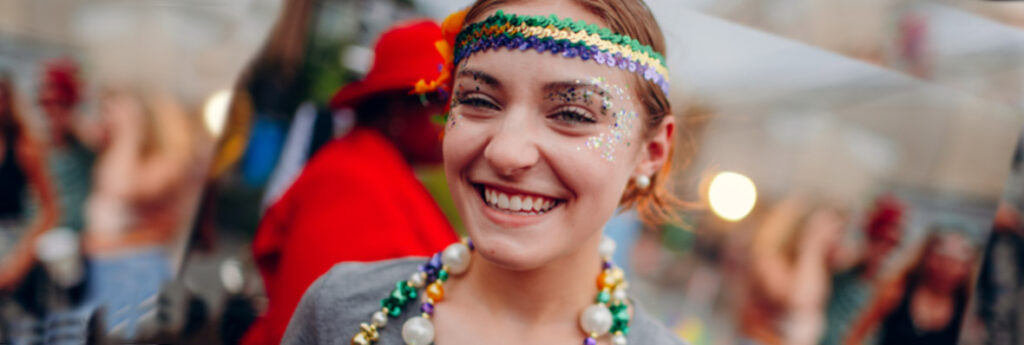Even if you consider yourself a Mardi Gras expert, we’re here to say you haven’t seen anything yet! Let’s go over a few basic terms you’ll want to know before you don a mask and head out for your Carnival experience, shall we?
- Mardi Gras – This is French for “Fat Tuesday,” a reference to the fact that Mardi Gras always is the day before Ash Wednesday, the beginning of Lent in the Catholic faith. Because the 40 days of Lent are considered a somber period of sacrifice, Fat Tuesday is seen by many as an appropriate time for indulgence and festivity – a last chance at revelry.
- Carnival – This word is not interchangeable with “Mardi Gras.” Carnival refers to the whole period of time leading up to Fat Tuesday officially beginning on the Feast of the Epiphany, also known as Twelfth Night (12 days after Christmas). Festivities kick off on a small scale at this time, then gradually pick up steam, peaking with many parades, balls and parties on the final two weekends before Mardi Gras.
- Krewe – This is a Carnival organization made up of members who plan and carry out various themed parades and balls. In keeping with the “mystical” tradition of Carnival, some of the oldest krewes keep their membership shrouded in secrecy. This is why krewes require members to wear masks during parades.
- Parade – OK, everybody knows what this is, but if you haven’t seen a Mardi Gras parade, well, you haven’t really seen a parade. For Louisiana parades, krewes build huge, elaborate floats that carry riders who may number in the dozens. You’ll find everything from the extravagant New Orleans floats to puppy parades (an absolute must if you like a pooch in a costume).
- Throws – Around here, we call the parade trinkets “throws.” The most common throws are strings of plastic beads that parade-goers love to collect and wear around their necks as “trophies” from their parade experience. Each krewe usually also throws doubloons, medallions, small toys and plastic cups imprinted with the krewe logo. Some more unusual throws can be found, like at the Krewe of Highland in Shreveport, who throws ramen noodles and hot dogs.
- King Cake – You’ll want to sample this Carnival tradition for sure! This sweet cinnamon-swirled dough twisted and shaped into an oval is decorated with the official colors of Mardi Gras. Purple, green and gold represent justice, faith and power respectively. Be alert: A plastic baby is “hidden” in every king cake; this is to celebrate the feast of the Epiphany, when Jesus first showed himself to the three wise men and to the world. If find the baby in your slice, you provide the king cake for the next gathering!
- Courir de Mardi Gras – Also known as Cajun Mardi Gras, can be found in the Lafayette area. Rooted in French medieval history and brought to Louisiana in the 19th century, Courir de Mardi Gras features the traditional courir or “run” led by the capitaine of the Mardi Gras. Costumed and masked participants on horseback or on foot make their way through the area from house to house, singing and dancing for the owners, begging for ingredients to ultimately make a large communal gumbo to be served later that evening. The last ingredient, and the highlight of the entire celebration, is the chicken.
Want to join in? Learn more about New Orleans Mardi Gras and experience more Mardi Gras fun throughout other regions in South, Central and North Louisiana. Don’t miss out on this annual celebration. Visit LouisianaTravel.com/MardiGras and plan your Carnival!

